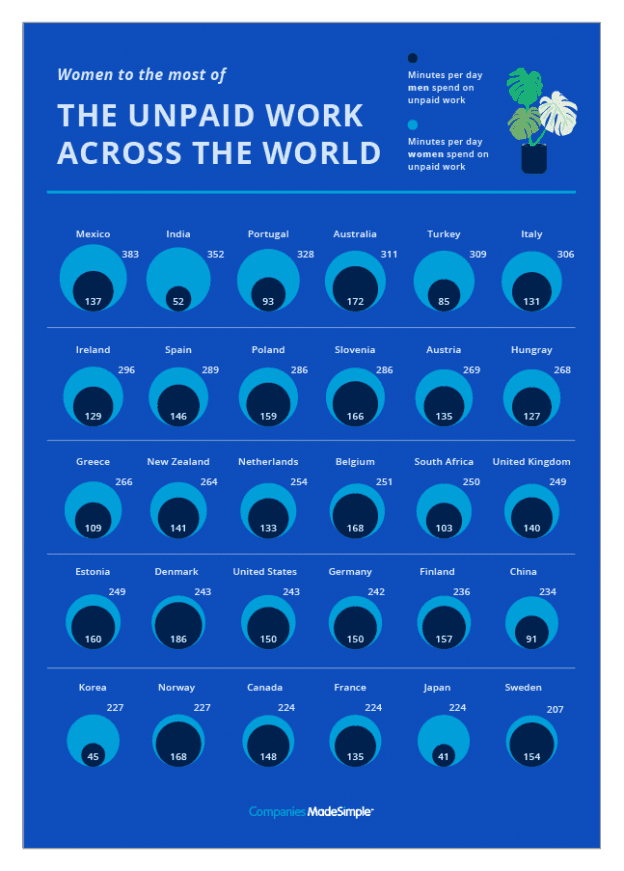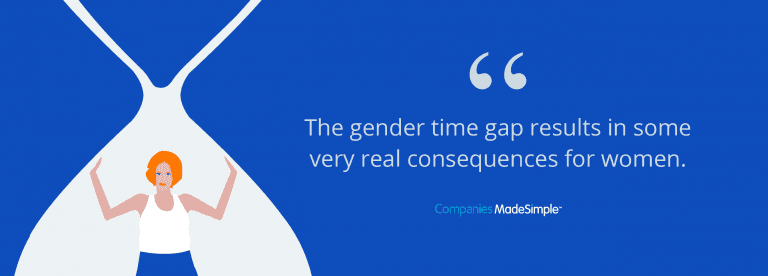Search ideas, news and case studies
Blog Categories
Women in Business Series: The Time Gap.

Here's an insight into the gender time gap
Welcome to our series: Women in Business. Over August, our four-part blog series delves into the current business environment and the state of female entrepreneurship. Examining the current landscape of female entrepreneurship and the challenges and setbacks faced by women who want to start their own ventures.
Our last blog explored the funding gap and a few ways lack of funding affects female entrepreneurs.
What is the gender time gap?
In relation to men, women have less leisure or free time. This is because women spend more time partaking in caregiving and housework duties, otherwise known as ‘unpaid or invisible work’. This isn’t because women choose to spend more time on these tasks, but due to factors like socialisation, they are expected to. On a positive note, in the UK the time gap is far less (where women spend around 1 hour 49 minutes more on unpaid work compared to men) compared to other countries such as Japan, just over 3 hours, or Egypt, around 4 hours. However, we can still keep improving, for example, Sweden has a time gap of around 50 minutes.
The gender time gap and the distribution of these invisible tasks raise concerns about fairness (given that both parties require these domestic tasks to be completed- why are the tasks disproportionately shared?) but it also costs. In fact, using OECD data, Melinda Gates wrote that reducing women’s unpaid labour from 5 to 3 hours a day can result in an increase of 10% in the female labour participation rate, and increase the global GDP by 12%. It can also be argued that if we included the 90 billion hours of unpaid work done by women globally in measuring GDP, the economic value of this work could be anything from 20 to 60%.
How can the economy grow if jobs such as cooking, gathering water and food, caregiving, shopping, child care etc. are not done? These tasks are what we label as ‘invisible work’ but they are essential to the world’s economy. Yet only paid labour is considered to make an impact, or mentioned in GDP figures. In this way, the gender time gap not only reduces women’s participation in labour but also discredits the importance of invisible work, predominantly marking it as women’s work.

When individuals have more free time, they have more opportunities for rest, opportunities for hobbies and of course, work and personal development. In terms of female entrepreneurship, the lack of free time for women directly translates into a lack of participation in entrepreneurship.
As a note, the gender time gap affects women worldwide yet the type of invisible work women do varies from country to country. In the UK the work can be laundry, cleaning or cooking but in other countries such as Kenya or Brazil, the work can be strenuous such as gathering firewood or water from a well. This also corresponds with what freedoms unpaid work restricts. Here in the UK, more leisure time may mean conceptualising a business but in other countries, more leisure time means crucial rest, the chance to attend school or go to hospital. While this blog will only examine the gender time gap in the context of the UK and similar countries, it is important to acknowledge the ways in which it encroaches on the freedoms and development of women and girls worldwide.
What causes the gender time gap?
The time gap has substantially deep causes. From birth onwards, children are exposed to traditional gender roles which shows women taking secondary/supportive roles alongside invisible work which aids men’s primary roles. Then in education, from childhood to adulthood, our conditioning of these gender roles is largely not challenged or not challenged strongly enough.
Essentially, women are expected to be the main caregivers and household managers. If women choose not to do so, society doesn’t provide adequate support for them to relinquish these roles. For example, most nurseries and childcare provisions finish at 3 pm, paid paternal leave is capped at 2 weeks, and sometimes men are not supporting or taking over household or care duties without direction.

The gender time gap results in some very real consequences for women. For example, more women in the UK work part-time to fit around unpaid work or those who are employed full-time spend money on nannies or childcare provisions. This means women both make and save less money, they have less in their pensions pots, and they get overlooked for promotions as they’re not there as often. Additionally, it makes things like entrepreneurship, which may be fun and exciting for men, feel impossible for women. If women can’t find the time to balance employment and their invisible work, how can that translate to doing something as time-demanding as entrepreneurship?
How to combat the gender time gap
Of course, when there is less time, it seems as if starting a business is counteractive, but as an entrepreneur, time can be reclaimed. Entrepreneurs can choose how to work which can aid in balancing unpaid labour. Of course, entrepreneurship is a fresh start, which can allow a fresh start within the home too. It can provide an opportunity to equally balance the invisible tasks between partners or occupants in the home.
Other ways to manage time come from using digital software and tools, flexible hours and working patterns, using AI and starting small.

Flexible working
Flexible working applies to anything from working when you choose, to where you choose, to how. If women have caring duties, such as childcare, a flexible working schedule can mean very little change in their daily routine. Rather than trying to fit life around building a business, entrepreneurship fits into life.
Examples of flexible working may mean working an early morning or late night rather than during the day, or working only during the hours children are away at school or nursery. It can also mean no commuting, which is time saved. Women entrepreneurs may even consider working a 4-day week which seems to suit women’s productivity better. Essentially, entrepreneurs have more control over these factors of their working style than someone in paid employment. Therefore, having more control over time.
Start small
Not every company has to be fully running and operative in a short period of time. If an entrepreneur has very little time, it may be better to start slowly and build a foundation for success. For example, for a product selling business the first step may be to make stock or a website, then take it step by step after. By focusing on the day-to-day and the smaller tasks can help build a business up slowly and prepare it well for launch.
Not every venture is made equal, some may already have funding and a team, and most may just be one person and their limited resources. This means there is no right or wrong way to launch a business, if a pre-launch stage takes more time than usual due to constraints on free time, that doesn’t make a business or idea any worse, just shows a different form of resilient entrepreneurship.
Use AI and Disruptive Technology
AI is an extremely effective way to save time, and it is still in the early stages of its potential. Entrepreneurs can learn how to be AI literate and use it for anything from writing emails to marketing copy to even planning a work schedule. AI is easy to access and oftentimes free which means it takes very little resource investment to make it work.
There are multiple AI models available for hundreds of different uses. For example, business owners hoping to save time on replying to emails can use ChatGPT to craft emails or an email template for them. Entrepreneurs hoping to create blogs or other long-form marketing copy can rely on Jaspar AI or Notion. Notion AI can also be used to create frameworks, plans and schedules. These tasks which may have taken hours if not days to complete take a matter of minutes and can free an immense amount of time for planning or other more crucial tasks.
Of course, with AI it is easy to over-rely on AI-produced content. It is imperative to maintain a good human-AI balance and read through everything produced by AI models. Not everything is perfect or in some cases accurate. AI is incredibly useful but it can’t replicate human care, empathy and emotion.
Using Digital Software
Not many small businesses, particularly women-owned ventures, make use of the digital software which is widely available. Small Business Britain, in their Moving Forward report, states that Digital plays a critical role at the heart of growth and resilience, and businesses need to be open to new things; new technology, and innovation (even small things) in digital and also in finance. Digitalising is the best way to grow as a business and implementing it in early stages can save masses of time and money. It may sound counter-intuitive to pay for software to save money, but digital software reduces human-error mistakes which in turn saves time and money used to fix mistakes.
For example, one process of entrepreneurship that can be outsourced to digital software is bookkeeping. A business must pay its taxes, and balance its profit, expenses and revenue but this can be extremely time-consuming and difficult. Particularly for financially illiterate entrepreneurs. Using accounting software means the hours of administration spent on bookkeeping become minutes of inputting figures. It also results in fewer errors and no surprises from HMRC if an error is made. This is just one example of digitalisation. Anything from scheduling social media posts to taking payments to customer service to project management can be digitalised. Couple this with using AI, a huge amount of time can be freed up. Of course, not every software is needed or useful, so entrepreneurs must do their own research into digitalising before embarking on it.
Over the month of August, our four-part blog series covered challenges faced by female entrepreneurs and laid out a few actionable suggestions to combat them. Our series ends with this final blog, but we will continue to champion female entrepreneurship in any way possible. Keep an eye out on our social media to follow the next steps of our ‘Women in Business’ campaign.






